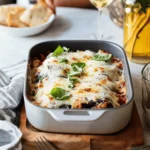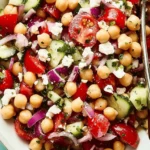A Southern classic, this crispy buttermilk fried chicken is juicy on the inside and perfectly crunchy on the outside. The chicken is marinated in seasoned buttermilk, then dredged in a flavorful flour coating and fried to golden perfection. It’s comfort food at its finest and a guaranteed crowd-pleaser.
FULL RECIPE
Ingredients
- 3 ½ lbs bone-in, skin-on chicken pieces (drumsticks, thighs, breasts)
- 2 cups buttermilk
- 1 tablespoon hot sauce (optional)
- 2 teaspoons salt (divided)
- 1 teaspoon black pepper (divided)
- 2 cups all-purpose flour
- 1 teaspoon paprika
- 1 teaspoon garlic powder
- 1 teaspoon onion powder
- ½ teaspoon cayenne pepper (optional)
- Vegetable oil, for frying
Directions
- In a large bowl, combine buttermilk, 1 teaspoon salt, ½ teaspoon pepper, and hot sauce if using.
- Add chicken pieces to the buttermilk mixture, ensuring they are fully submerged. Cover and refrigerate for at least 4 hours or overnight.
- In another large bowl, mix flour, remaining salt and pepper, paprika, garlic powder, onion powder, and cayenne pepper.
- Remove chicken from marinade, letting excess drip off. Dredge each piece in the seasoned flour, pressing the coating onto the chicken. Set aside on a wire rack.
- Heat 2–3 inches of vegetable oil in a deep skillet or Dutch oven to 325°F (163°C).
- Fry chicken in batches, turning occasionally, until golden brown and cooked through (internal temperature should reach 165°F/74°C), about 12–15 minutes.
- Drain on a wire rack or paper towels. Let rest 5 minutes before serving.
Nutritional Information
- Calories: 430 per serving
- Protein: 28g
- Carbohydrates: 15g
- Fat: 28g
- Saturated Fat: 6g
- Cholesterol: 115mg
- Sodium: 650mg
- Fiber: 1g
- Sugar: 2g
History of Fried Chicken
Fried chicken has deep roots in culinary traditions that span cultures and continents. While it is most famously associated with the American South, its origins go back to Scottish frying techniques and West African seasoning traditions. Scottish immigrants brought their method of frying unseasoned chicken in fat, while African slaves introduced bold spices. Over time, these traditions merged in the Southern United States to create the flavorful, crispy fried chicken we know today.
Why Buttermilk Makes a Difference
Buttermilk is a key component in tenderizing chicken before frying. Its mild acidity breaks down protein structures in the meat, making it softer and juicier. The buttermilk also helps the flour coating adhere better, creating that signature crispy crust. The longer the chicken marinates in buttermilk, the more flavorful and moist the result will be.
The Science Behind Crispy Coating
Achieving the perfect crispy texture is about more than just heat. The combination of seasoned flour and moisture from the chicken skin forms a paste-like crust that fries up into a golden, crunchy layer. Paprika and other dry spices in the coating contribute both flavor and a rich color. Using the right oil temperature is critical; too low and the chicken becomes greasy, too high and it burns before cooking through.
Choosing the Right Chicken Cuts
Bone-in, skin-on pieces like thighs, legs, and breasts are traditional and provide the most flavor. The skin crisps up beautifully during frying, while the bone helps retain juiciness. Some cooks prefer dark meat for its richer flavor and tenderness, while others opt for a mix to satisfy all preferences at the table.
Oil Selection for Frying
Neutral oils with high smoke points such as vegetable, peanut, or canola oil are ideal for frying chicken. These oils can handle the high temperatures needed without imparting a strong flavor. It’s also important to monitor the oil temperature and maintain consistency throughout the cooking process for even browning.
Frying Techniques: Skillet vs. Deep Fryer
Both skillet frying and deep frying can yield excellent results, but each method has its pros and cons. Skillet frying allows for a crisper bottom crust but may require more attention to avoid uneven cooking. Deep frying immerses the chicken fully in oil, promoting a uniform golden color and crispness but requires more oil and equipment.
Flavor Customization Options
Fried chicken is highly adaptable. Adding different spices to the marinade or coating can change the flavor profile. Cayenne pepper adds heat, while herbs like thyme or oregano lend an earthy taste. For a sweeter spin, some cooks add a touch of sugar or honey to the batter or drizzle it on after frying.
Serving Suggestions
Crispy buttermilk fried chicken pairs wonderfully with classic Southern sides like mashed potatoes, coleslaw, mac and cheese, or biscuits. It’s also a great centerpiece for picnics, family dinners, or casual get-togethers. Cold fried chicken even makes for a popular leftover option the next day.
Making It Healthier
Though traditionally indulgent, there are ways to lighten this dish. Using skinless chicken cuts, shallow frying in less oil, or opting for oven-fried techniques can reduce fat and calorie content. Air fryers have also become a popular way to enjoy crispy chicken with minimal oil.
Cultural Significance in the South
In Southern culture, fried chicken is more than just food—it’s a symbol of hospitality and comfort. It’s often featured at Sunday dinners, church gatherings, and family reunions. Generations of cooks pass down their unique recipes, each with slight variations in seasoning and preparation.
Common Mistakes to Avoid
Overcrowding the pan is one of the most common issues when frying chicken. It causes the oil temperature to drop, resulting in soggy, unevenly cooked chicken. Another mistake is skipping the rest time after frying, which helps the crust set and the juices redistribute within the meat.
Storage and Reheating Tips
Store leftover fried chicken in an airtight container in the refrigerator for up to four days. For reheating, avoid the microwave as it can make the crust soggy. Instead, use an oven or air fryer to restore the crispiness while keeping the interior moist.
How to Make It Extra Crispy
Double-dipping in flour or using a wet batter can increase crunch. Some chefs add cornstarch or baking powder to the flour to boost crispiness. Letting the dredged chicken sit for 10–15 minutes before frying also helps the coating adhere and crisp up better.
Regional Variations in Fried Chicken
From Nashville hot chicken to Korean-style fried chicken, there are many regional variations that bring unique twists to the classic. Nashville style is known for its intense spice, while Korean fried chicken is double-fried for an ultra-thin, crispy crust. Each variation showcases local flavors and preferences.
Pairing with Sauces
While classic fried chicken often stands on its own, dipping sauces can enhance the experience. Popular choices include honey mustard, spicy ranch, hot sauce, or even gravy. Each sauce adds a different layer of flavor that complements the savory, crunchy chicken.
Meal Planning with Fried Chicken
Fried chicken can serve as the foundation for multiple meals. Leftovers can be used in sandwiches, salads, or wraps. Preparing a larger batch makes it easy to have ready-to-go protein for a few days, reducing time spent cooking during the week.
Kids and Family Appeal
Fried chicken is a family favorite across all age groups. Its mild flavor and crunchy coating make it especially appealing to kids. It’s also a great dish for introducing children to cooking, as they can help with dredging and seasoning under supervision.
Holiday and Celebration Food
Many people include fried chicken in holiday menus, especially for summer celebrations like the Fourth of July or Memorial Day. Its comfort-food status and crowd-pleasing nature make it ideal for potlucks and festive gatherings where you want something hearty and satisfying.
Gluten-Free Alternatives
For those with dietary restrictions, gluten-free flour blends or crushed rice cereal can be used instead of wheat flour. Many gluten-free batters still produce a crispy, golden crust when fried properly. Just be sure to check all seasoning mixes for hidden gluten sources.
Conclusion
Crispy buttermilk fried chicken is a timeless dish that continues to evolve while maintaining its classic appeal. From its historical origins to its place on modern tables, it bridges generations and cultures through flavor and tradition. Whether made for a special gathering or a weeknight treat, it satisfies like few other foods can. By understanding the techniques, ingredients, and variations, anyone can master this delicious and comforting recipe.






